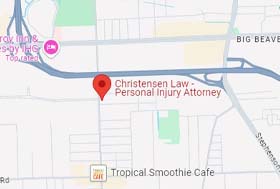Distracted driving remains one of the gravest traffic safety concerns in the United States. Despite widespread public awareness campaigns, legislative efforts, and technological advancements, thousands of accidents yearly are linked to driver inattention.
The present meta-analysis by Christensen Law explores the dangers of distracted driving, emphasizing how driver inattentiveness is still a leading cause of crashes despite legal restrictions and public education efforts.
At the end of this analysis, we also present a case study on Michigan, a state that defies the national trend of rising distracted driving fatalities.
Unlike many other states, Michigan has maintained relatively stable distracted driving fatality rates while others have experienced significant increases. This raises an important question: What is Michigan doing differently?
What Is Distracted Driving and Why It Is Still a Nationwide Problem
Distracted driving encompasses far more than phone use, and research shows that many other activities can be just as dangerous. The NHTSA defines distracted driving as follows:
any activity that diverts attention from driving, including talking or texting on your phone, eating and drinking, talking to people in your vehicle, [and] fiddling with the stereo, entertainment or navigation system.
In 2021 alone, NHTSA estimates that 3,522 people were killed in crashes involving distracted drivers – about 8% of all U.S. traffic fatalities that year.
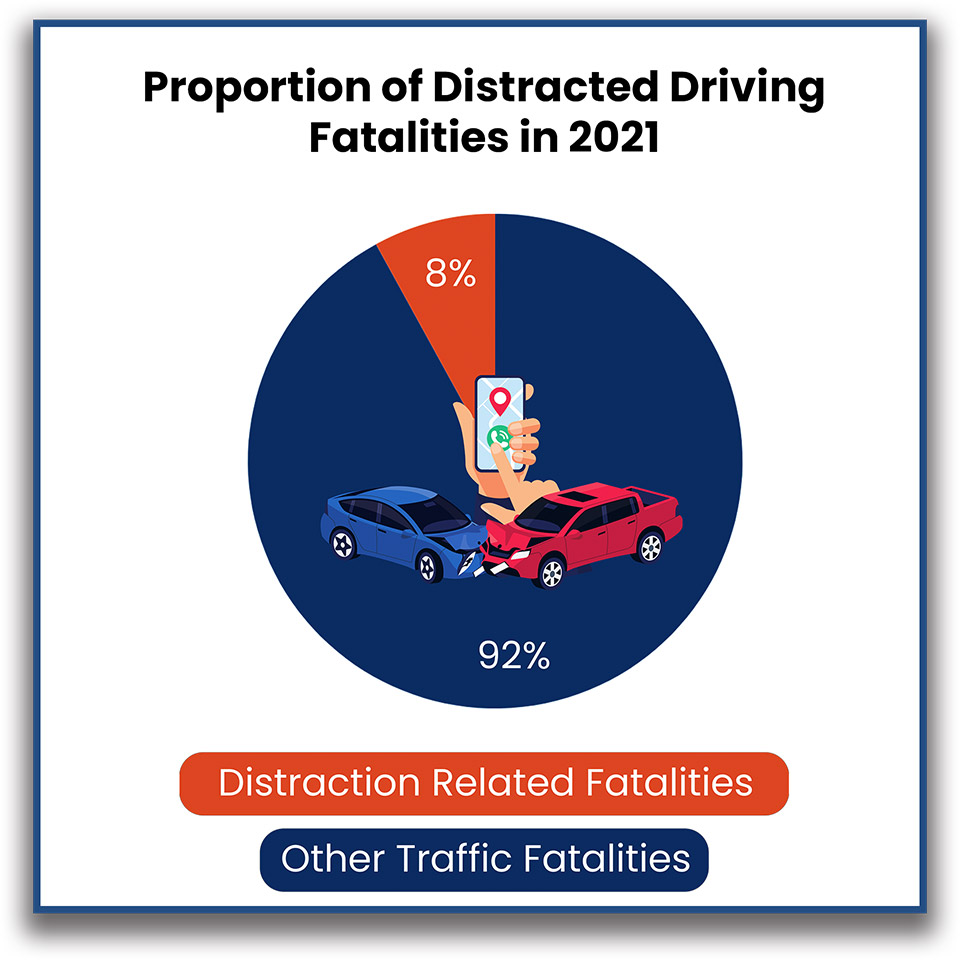
Distracted Driving Injuries and Fatalities: National Statistics and Trends
According to NHTSA data, corroborated with CDC and Harvard University data, distracted driving-related fatalities have fluctuated in recent years, with an overall upward trend since the late 2010s. As a note, NHTSA defines “distracted-affected” crashes as any crash where at least one driver was identified as distracted.
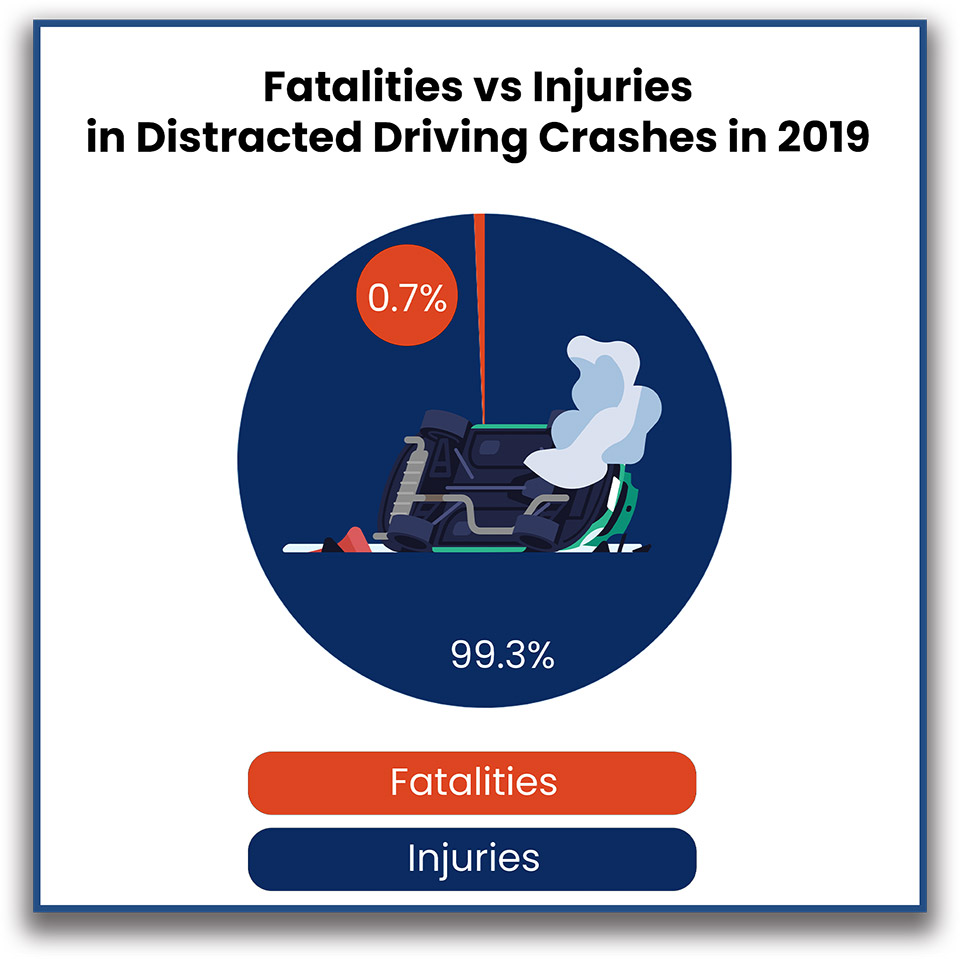 This pie chart compares the number of fatalities (3,100) to the number of people injured (424,000) in distracted-driving-related crashes. As shown, the overwhelming majority of affected individuals are injured rather than killed. This highlights the widespread impact of distracted driving on road safety, even if not all cases are fatal.
This pie chart compares the number of fatalities (3,100) to the number of people injured (424,000) in distracted-driving-related crashes. As shown, the overwhelming majority of affected individuals are injured rather than killed. This highlights the widespread impact of distracted driving on road safety, even if not all cases are fatal.
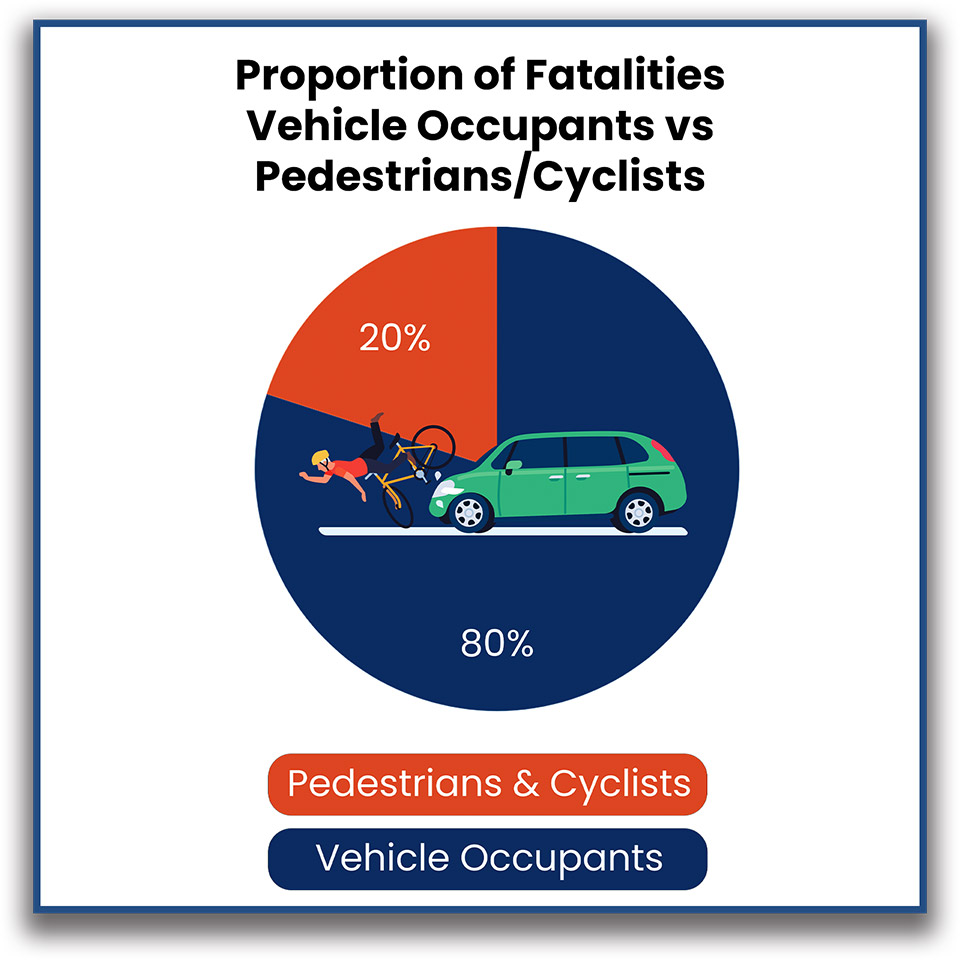
About 1 in 5 people that pass away in distracted driving crashes were not inside a vehicle—they were pedestrians or cyclists. This underscores that distracted driving is not just a risk for those behind the wheel but also for vulnerable road users who share the streets.
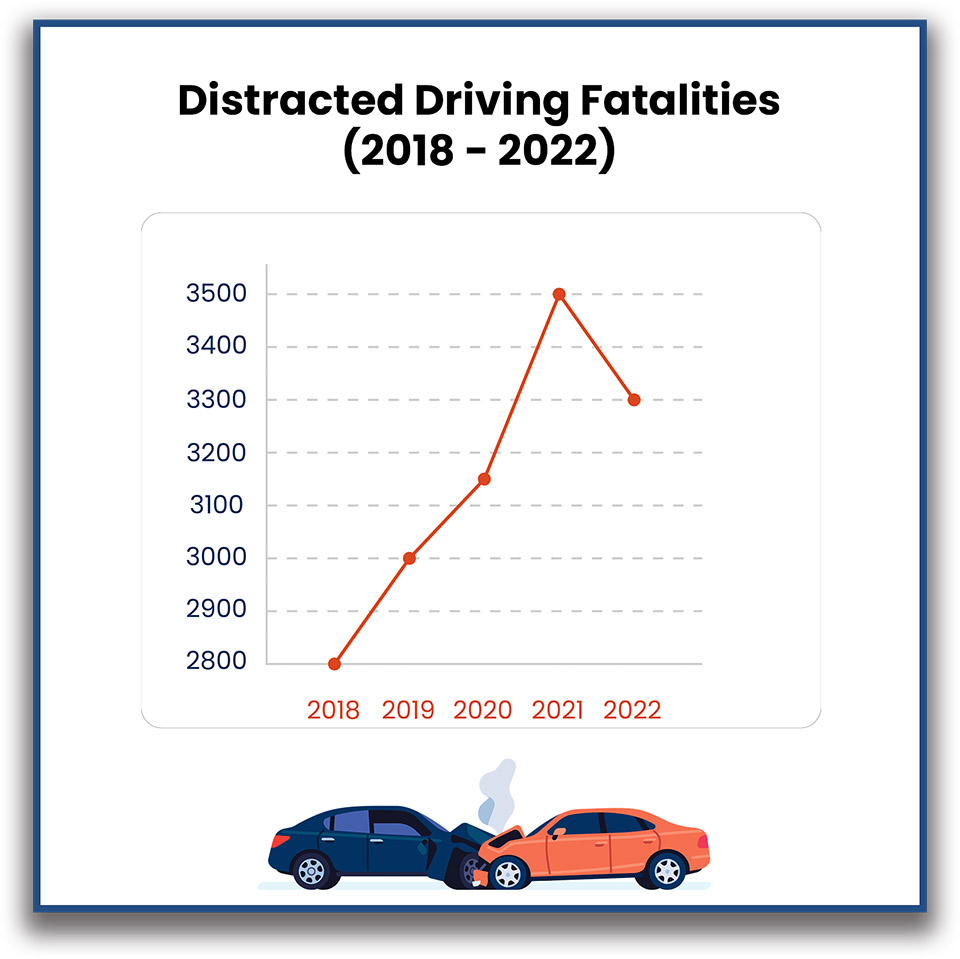
This line chart shows how fatalities from distracted driving fluctuated over the years. The numbers remained relatively stable around 3,000 in the late 2010s but saw a significant spike in 2021, reaching 3,522 deaths—the highest in over a decade. This increase aligns with overall riskier driving behaviors observed during the pandemic. Fortunately, 2022 saw a slight decrease in fatalities, signaling some improvement.

In 2021, distraction-related crashes accounted for about 8% of all the traffic death toll in the U.S. This pie chart illustrates the proportion of deaths linked to distracted driving versus all other traffic-related fatalities that year. While distracted driving isn’t the leading cause of traffic deaths, it remains a significant factor contributing to roadway danger.
Using the Fatality and Injury Reporting System Tool (FIRST) developed by NHTSA, we analyzed traffic fatalities across the U.S. to identify trends in distracted driving deaths. This data provides a comprehensive look at how distraction-related crashes contributed to roadway fatalities. The table below presents the state-by-state breakdown of distracted driving fatalities in 2022, offering insight into total deaths and how they compare to national trends.
| STATE NAME | Fatal Crashes: Total Number | Fatal Crashes: Involving Distracted Driver | % of Fatal Crashes Involving Distracted Driver | Total Number of Fatalities from Distracted Driving Crashes | 2022 Population (Census) | Distracted Driving Fatalities Per 1M People |
|---|---|---|---|---|---|---|
| Alabama | 913 | 45 | 4.93% | 46 | 5,076,181 | 8.9 |
| Alaska | 75 | 2 | 2.67% | 2 | 734,442 | 2.7 |
| Arizona | 1183 | 62 | 5.24% | 70 | 7,377,566 | 8.4 |
| Arkansas | 583 | 27 | 4.63% | 32 | 3,047,704 | 8.9 |
| California | 4109 | 139 | 3.38% | 148 | 39,142,414 | 3.6 |
| Colorado | 699 | 64 | 9.16% | 70 | 5,850,935 | 10.9 |
| Connecticut | 325 | 8 | 2.46% | 8 | 3,617,925 | 2.2 |
| Delaware | 143 | 8 | 5.59% | 8 | 1,020,625 | 7.8 |
| District of Columbia | 28 | 2 | 7.14% | 2 | 676,725 | 3.0 |
| Florida | 3298 | 247 | 7.49% | 265 | 22,379,312 | 11.0 |
| Georgia | 1678 | 71 | 4.23% | 73 | 10,931,805 | 6.5 |
| Hawaii | 111 | 23 | 20.72% | 25 | 1,440,359 | 16.0 |
| Idaho | 194 | 30 | 15.46% | 35 | 1,944,299 | 15.4 |
| Illinois | 1147 | 76 | 6.63% | 82 | 12,621,821 | 6.0 |
| Indiana | 884 | 78 | 8.82% | 86 | 6,844,545 | 11.4 |
| Iowa | 307 | 13 | 4.23% | 13 | 3,202,820 | 4.1 |
| Kansas | 364 | 88 | 24.18% | 110 | 2,937,324 | 30.0 |
| Kentucky | 693 | 121 | 17.46% | 128 | 4,519,233 | 26.8 |
| Louisiana | 852 | 144 | 16.90% | 157 | 4,593,687 | 31.3 |
| Maine | 171 | 11 | 6.43% | 11 | 1,390,922 | 7.9 |
| Maryland | 532 | 37 | 6.95% | 39 | 6,192,440 | 6.0 |
| Massachusetts | 412 | 38 | 9.22% | 38 | 7,022,468 | 5.4 |
| Michigan | 1054 | 55 | 5.22% | 59 | 10,050,877 | 5.5 |
| Minnesota | 418 | 18 | 4.31% | 18 | 5,721,621 | 3.1 |
| Mississippi | 646 | 12 | 1.86% | 12 | 2,941,939 | 4.1 |
| Missouri | 962 | 80 | 8.32% | 86 | 6,179,414 | 12.9 |
| Montana | 184 | 18 | 9.78% | 19 | 1,122,095 | 16.0 |
| Nebraska | 214 | 11 | 5.14% | 11 | 1,972,246 | 5.6 |
| Nevada | 383 | 11 | 2.87% | 11 | 3,176,116 | 3.5 |
| New Hampshire | 137 | 6 | 4.38% | 6 | 1,396,678 | 4.3 |
| New Jersey | 642 | 170 | 26.48% | 183 | 9,295,227 | 18.3 |
| New Mexico | 419 | 167 | 39.86% | 185 | 2,113,868 | 79.0 |
| New York | 1105 | 114 | 10.32% | 121 | 19,703,747 | 5.8 |
| North Carolina | 1500 | 46 | 3.07% | 49 | 10,710,793 | 4.3 |
| North Dakota | 96 | 5 | 5.21% | 6 | 781,057 | 6.4 |
| Ohio | 1180 | 52 | 4.41% | 55 | 11,777,874 | 4.4 |
| Oklahoma | 643 | 48 | 7.47% | 50 | 4,026,229 | 11.9 |
| Oregon | 553 | 36 | 6.51% | 39 | 4,247,372 | 8.5 |
| Pennsylvania | 1092 | 61 | 5.59% | 70 | 12,984,990 | 4.7 |
| Rhode Island | 51 | 1,099,498 | 0.0 | |||
| South Carolina | 1019 | 32 | 3.14% | 33 | 5,287,935 | 6.1 |
| South Dakota | 121 | 7 | 5.79% | 7 | 909,723 | 7.7 |
| Tennessee | 1215 | 62 | 5.10% | 68 | 7,062,217 | 8.8 |
| Texas | 3966 | 440 | 11.09% | 495 | 30,113,488 | 14.6 |
| Utah | 296 | 16 | 5.41% | 17 | 3,391,011 | 4.7 |
| Vermont | 73 | 3 | 4.11% | 3 | 648,142 | 4.6 |
| Virginia | 946 | 91 | 9.62% | 95 | 8,683,414 | 10.5 |
| Washington | 691 | 93 | 13.46% | 97 | 7,794,123 | 11.9 |
| West Virginia | 248 | 11 | 4.44% | 12 | 1,774,122 | 6.2 |
| Wisconsin | 548 | 38 | 6.93% | 41 | 5,903,975 | 6.4 |
| Wyoming | 118 | 10 | 8.47% | 12 | 581,978 | 17.2 |
Is the Distracted Driving Problem Growing or Easing on a National Level?
The data suggest a mixed picture. Through 2019, distracted driving deaths had been relatively stable or slowly rising. 2020 did not see a major drop in distracted fatalities despite lockdowns (only a slight increase from 2019), and by 2021 the numbers jumped sharply. The slight decline in 2022 is encouraging, but fatalities remained higher than the pre-pandemic norm.
NHTSA officials warn that distracted driving remains a serious problem, likely underreported in crash data. One analysis noted that distraction was officially cited in 8.2% of 2021 crash deaths. Still, the true impact could be higher because distraction often goes unrecorded – it’s hard to prove, and many drivers won’t admit to being on the phone after a crash.
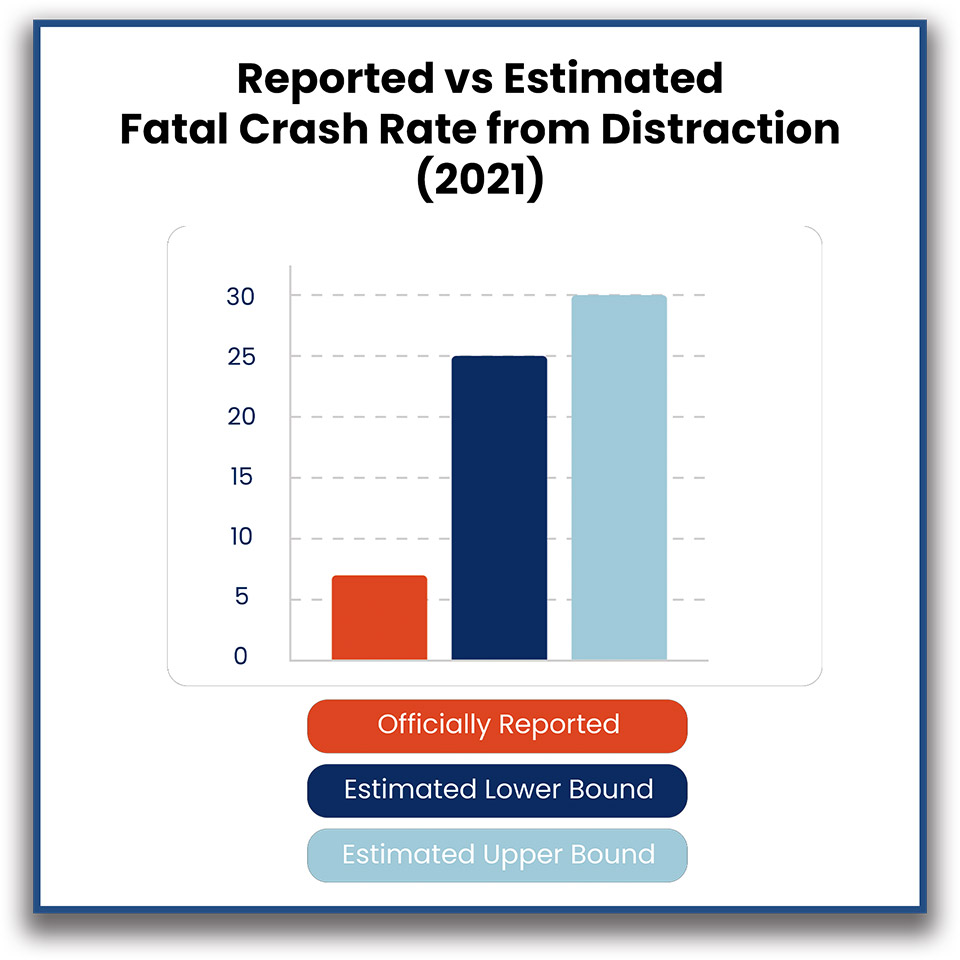
Indeed, traffic safety experts estimate the actual portion of fatal crashes involving distraction might be 25–30% – several times the reported figure. In short, while 2022 saw a modest improvement, the five-year trend indicates distracted driving fatalities have not returned to earlier lows, suggesting the problem has worsened overall compared to five years ago.
| Year | Total U.S. Fatalities from Distracted Driving |
|---|---|
| 2018 | ~2,850 |
| 2019 | 3,142 |
| 2020 | 3,154 |
| 2021 | 3,522 |
| 2022 | 3,308 |
The NHTSA and the CDC have been raising alarms. The CDC emphasizes that these crashes are preventable and often involve everyday behaviors (texting, eating, using in-car screens) that take attention off the road.
The NHTSA’s Deputy Administrator in 2023 stressed the need to use “all the tools” available – from stronger state laws and high-visibility enforcement campaigns to public education and technology that disables phones while driving – to curb the recent surge in distraction-related harms.
In April (Distracted Driving Awareness Month) each year, the NHTSA runs its “U Drive. U Text. U Pay.” campaign to crack down on violators and remind us of the deadly consequences of driving distracted.
The Link Between Distracted Driving Fatalities and Legal Enforcement
While public awareness campaigns highlight the dangers, legal enforcement is critical in shaping driver behavior. States that impose strict penalties, enforce hands-free laws, and invest in public education tend to see lower distracted driving fatality rates than those with lenient or poorly enforced regulations.
The effectiveness of distracted driving laws depends on their existence and drivers’ awareness and compliance. Many states have introduced hands-free laws, yet public perception remains a challenge—do drivers know these laws exist, and do they believe they will be enforced?
How Do States Penalize Distracted Driving?
We reviewed fines and penalties for distracted driving across several states. The severity of fines and enforcement varies significantly across jurisdictions:
| State | Offense Type (Scope of Law) | First Offense Fine | Subsequent Offense Fines | Additional Penalties |
|---|---|---|---|---|
| Michigan | Hand-held device use banned | $100 | $250 | Three violations within three years require completion of a driver improvement course. Fines double if the violation results in a crash. |
| Minnesota | Hand-held ban for all drivers | $50 | Up to $275 | — |
| Wisconsin | General use of electronic devices | $20–$40 | $50–$100 (if within one year) | — |
| Indiana | Hand-held ban for all drivers | Up to $500 | Up to $500 | — |
| Illinois | Hand-held ban for all drivers | $75 | $100 (second offense), $125 (third offense), $150 (fourth and subsequent offenses) | — |
| California | Hand-held ban for all drivers | $20 | $50 | One point added to license for repeat offenses within 36 months. |
| Colorado | Texting while driving prohibited | $300 | $300 | Fines may increase up to $1,000 if texting causes an accident. |
| Georgia | Hand-held ban for all drivers | $50 | $100 (second offense), $150 (third offense) | 1 point (first offense), 2 points (second offense), 3 points (third offense). First-time offenders can have the charge dismissed if they prove they purchased a hands-free device. |
| Louisiana | Hand-held ban in school zones | $500 | Up to $1,000 | Possible 60-day license suspension for repeat offenders. |
| Missouri | Hand-held ban for all drivers (effective Jan 1, 2025) | $150 | $250 (second offense), $500 (third offense) | — |
| New York | Hand-held ban for all drivers | Up to $200 | Up to $450 | 5 license points per offense. Junior drivers face a 120-day license suspension for the first offense. |
| Oregon | Hand-held ban for all drivers | Up to $1,000 | Up to $2,500 | Possible 6-month jail time for a third offense within 10 years. |
| Texas | Texting while driving is prohibited | $25–$99 | $100–$200 | — |
| Virginia | Hand-held ban for all drivers | $125 | $250 | 3 demerit points per offense. |
| Washington | Hand-held ban for all drivers | $136 | $234 | “E-DUI” is recorded on the driving record and reported to insurance. An additional $99 fine may apply for other distractions causing a traffic violation. |
Key Observations
- States like Oregon and Louisiana impose some of the highest fines and additional penalties, including potential jail time or license suspension.
- California, Georgia, and Virginia implement license points for violations, affecting long-term driving records and insurance rates.
- Missouri’s new law (effective in 2025) marks a shift toward stricter enforcement in states that previously had weaker distracted driving laws.
- Wisconsin has the most lenient penalties, with fines as low as $20 and no escalating structure for multiple offenses.
- Michigan’s penalties align with a moderate deterrence model, balancing escalating fines with educational intervention (driver improvement course).
How Does Michigan Fit in this Bigger Picture of Nationwide Distracted Driving?
Michigan’s trends in distracted driving deaths in 2023 tell a somewhat different story compared to other states.
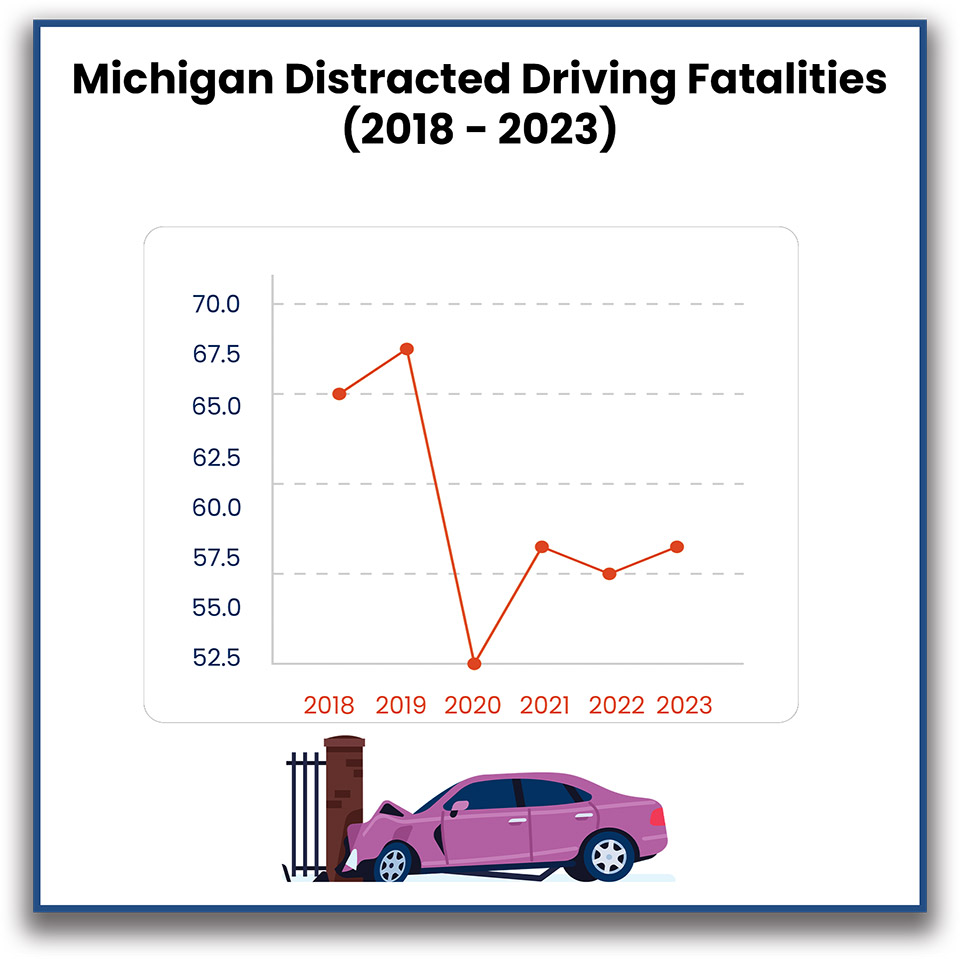 Michigan’s distracted driving fatalities did not follow the national pattern observed over the past five years. While many states experienced a significant increase in distracted driving-related deaths, particularly during the pandemic years (2020–2021), Michigan saw a relative decline or stabilization. The year 2023 saw another 59 fatalities, reinforcing the idea of a plateau rather than a sharp increase or decrease.
Michigan’s distracted driving fatalities did not follow the national pattern observed over the past five years. While many states experienced a significant increase in distracted driving-related deaths, particularly during the pandemic years (2020–2021), Michigan saw a relative decline or stabilization. The year 2023 saw another 59 fatalities, reinforcing the idea of a plateau rather than a sharp increase or decrease.
- 2019: Peak at 70 fatalities.
- 2020: Sharp drop to 52 fatalities (-25.7%).
- 2021-2022: Slight increase and stabilization (59 and 57 fatalities).
- 2023: Increased again to 59 fatalities, a 4% rise from 2022
This pattern is distinct from the national trend, where distracted driving deaths peaked in 2021 at 3,522 fatalities nationwide before slightly decreasing in 2022. While the U.S. saw a 16% increase in fatalities from 2018 to 2021, Michigan’s numbers suggest a more controlled outcome, possibly due to targeted legislation, enforcement measures, and public awareness campaigns.
Why Is Michigan Performing Better?
Several factors likely contributed to Michigan’s relative success in managing distracted driving fatalities compared to the national average:
A. Strengthened Legal Framework & Hands-Free Legislation
- Michigan has historically enforced strict texting-while-driving bans and recently passed a new “hands-free” law (effective June 30, 2023).
- The law bans drivers from holding or manually using a phone for calls, texting, GPS entry, or social media.
- A driver caught using a handheld phone pays a fine starting at $100 for the first transgression and $250 for subsequent violations. The penalties double if the violation results in a collision.
This proactive legal approach likely helped mitigate an increase in fatalities during 2020–2021, when distracted driving deaths surged in many other states – something a distracted driver lawyer in Michigan would recognize as a critical factor in legal outcomes.
B. Law Enforcement & Public Awareness Campaigns
In Michigan, targeting peak hours (especially afternoon rush hours) with enforcement efforts and awareness campaigns could help reduce crashes further.
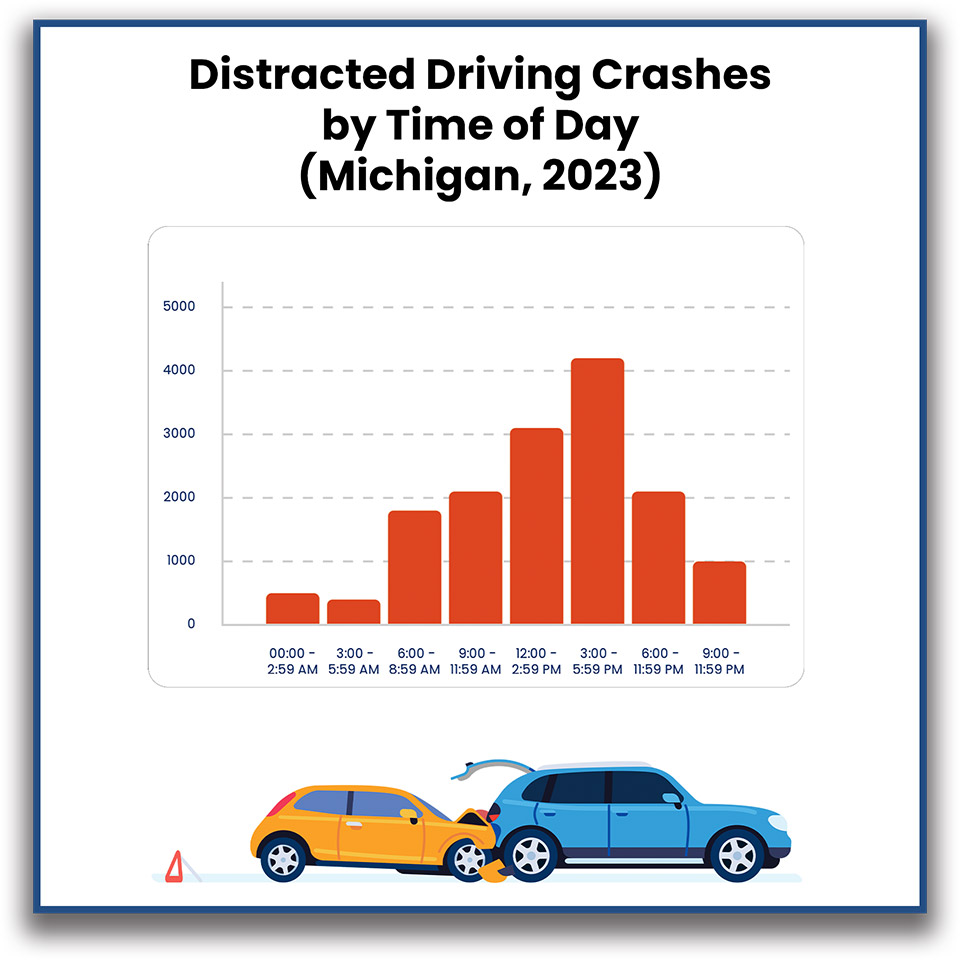
- The Michigan State Police and local law enforcement have been conducting aggressive ticketing and public education efforts targeting distracted driving.
- High-visibility campaigns like “U Drive. U Text. U Pay.” and “Put Your Phone Down, Just Drive” aim to reinforce the dangers of texting and driving. These efforts are particularly important given the well-documented dangers of distracted driving, which continue to cause thousands of preventable deaths each year.
- These ongoing initiatives have kept Michigan’s distracted driving fatality rates from rising to the levels seen in states with less aggressive enforcement strategies.
The Impact of the 2023 Hands-Free Law in Michigan
With the new hands-free law taking effect in mid-2023, Michigan may see further reductions in distracted driving deaths in 2023 and beyond. Early data from states that have implemented similar laws suggest that:
- Handheld phone bans reduce crash rates by 15–20% within the first two years.
- States with stricter hands-free laws see fewer repeat offenders than those with weaker penalties.
However, distractions from sources other than mobile phones (passengers, external activities) still play a major role in fatal crashes in Michigan. This suggests that future campaigns should not only focus on phone use but also general driver awareness.
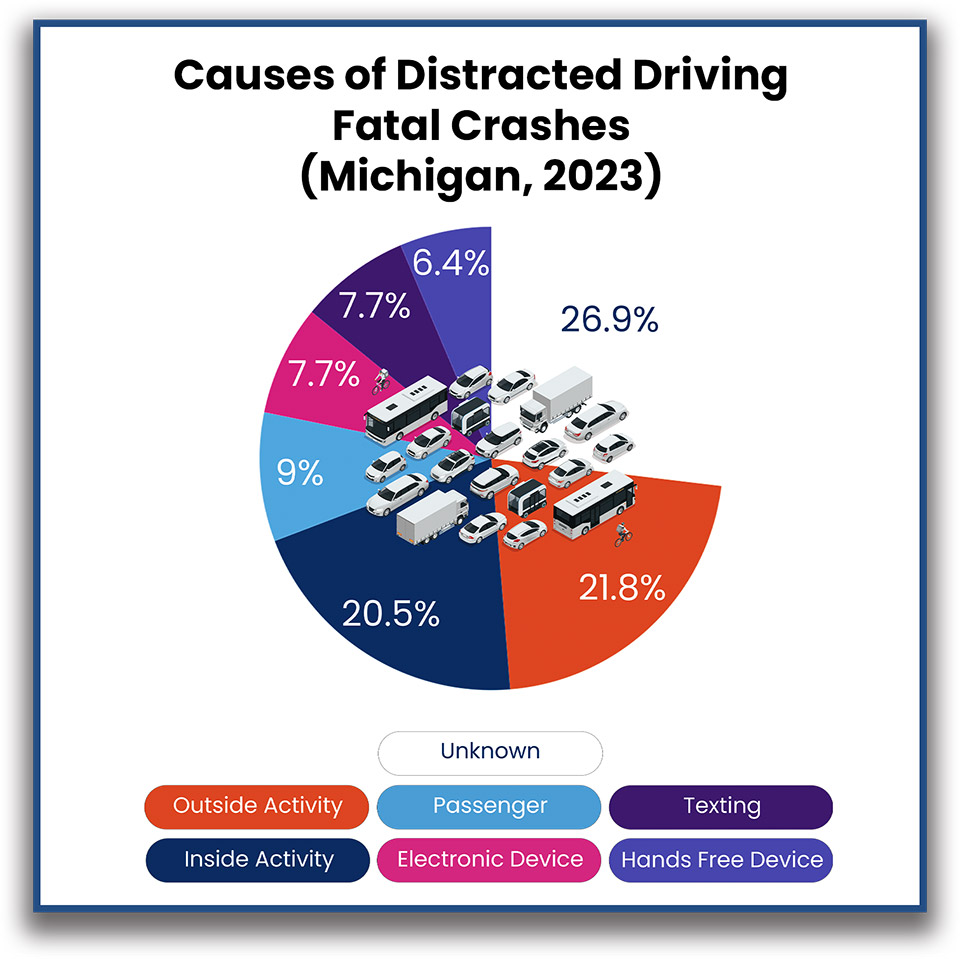 The most common distraction causes in fatal collisions in Michigan include:
The most common distraction causes in fatal collisions in Michigan include:
- External distractions (17 fatal crashes).
- Internal distractions (inside the vehicle) (16 fatal crashes).
- Passengers (7 fatal crashes).
- Electronic devices (including texting & hands-free devices) accounted for 17 fatal crashes combined.
Michigan’s distracted driving fatalities have remained relatively stable over recent years, in contrast to the national trend of rising deaths. While this suggests that enforcement efforts and legislation have been effective, the data highlights areas for further improvement.
The highest risk period for distracted driving crashes is between 3 PM and 5:59 PM, making targeted enforcement during these hours crucial.
Additionally, non-phone distractions, such as external events, passengers, and in-car activities, contribute significantly to fatal crashes, emphasizing the need for broader safety initiatives beyond just banning handheld phone use. Strengthening public awareness campaigns and expanding enforcement strategies could reduce distracted driving fatalities in Michigan.
Michigan’s Approach: What Can We Learn from It?
Michigan has bucked the national trend by keeping distracted driving fatalities relatively stable while other states saw surges. Strong enforcement, public awareness campaigns, and legislative measures have contributed to this success.
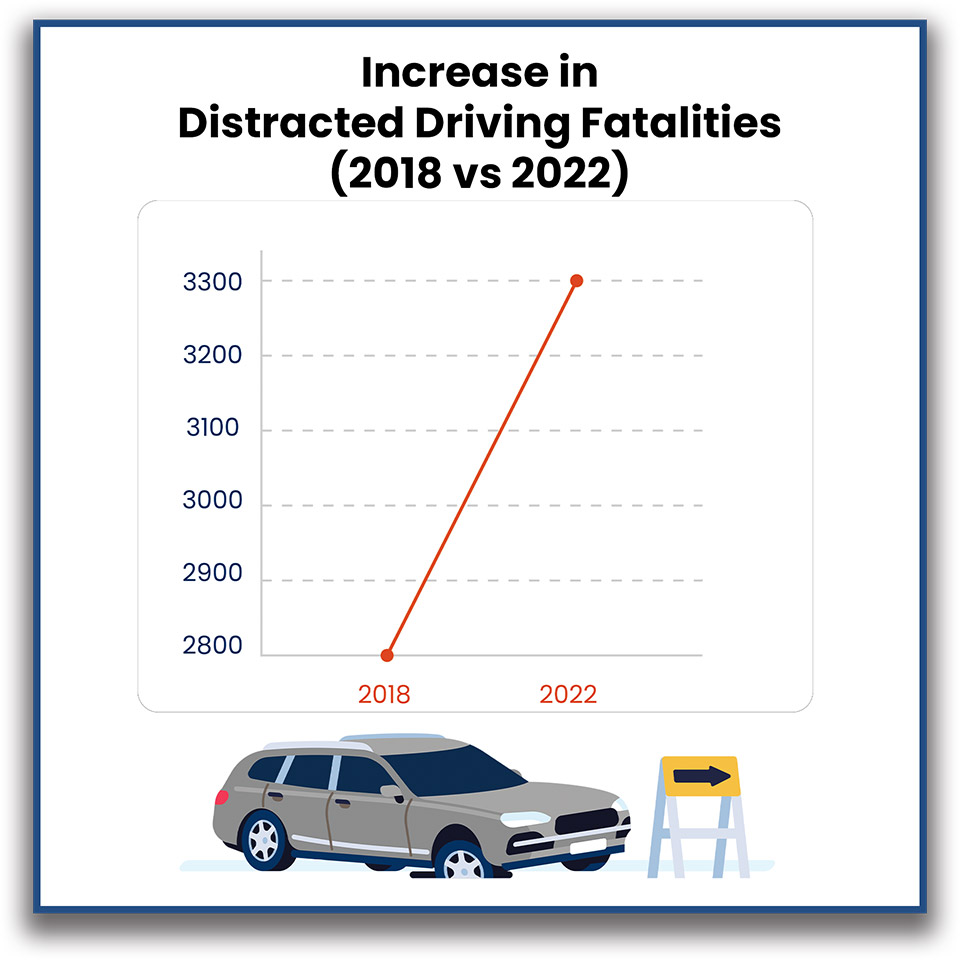 States like New Mexico (39.86% of fatal crashes involving distraction) and Louisiana (31.3 fatalities per million residents) serve as stark reminders of the consequences of inattentiveness behind the wheel.
States like New Mexico (39.86% of fatal crashes involving distraction) and Louisiana (31.3 fatalities per million residents) serve as stark reminders of the consequences of inattentiveness behind the wheel.
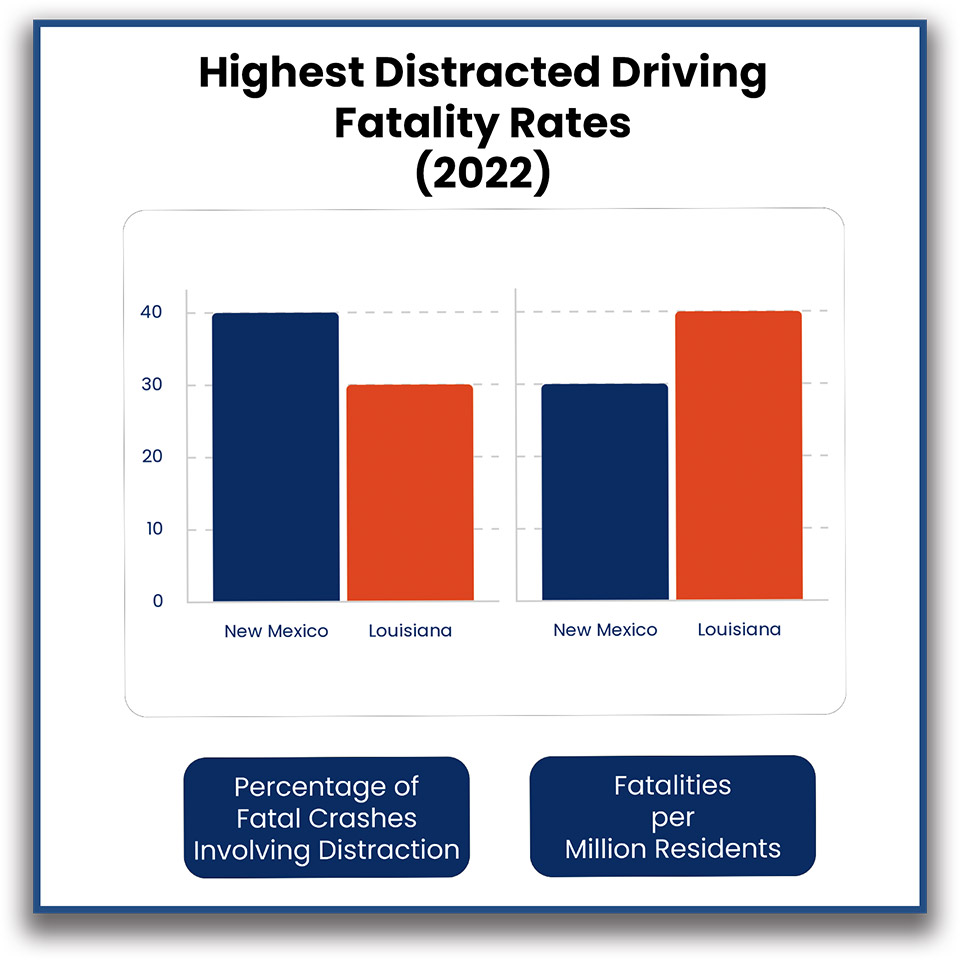
At the same time, Michigan’s unique trend—a relative decline in distracted driving fatalities over five years—offers an important counterpoint to the national picture. Unlike states that have seen increases in fatalities, Michigan’s proactive legal and enforcement strategies may provide a model for reducing distractions on the road.
This contrast between the rising national crisis and Michigan’s more controlled outcomes underscores the critical need for a deeper investigation into driver awareness, self-perception, and the role of legal measures.
Can Stricter Laws and Public Awareness Improve Safety When It Comes to Distracted Driving?
Distracted driving is not just an individual bad habit—it is a systemic public safety issue with legal, behavioral, and technological implications. Despite national efforts to curb distractions behind the wheel, more than 3,300 lives were lost in 2022 alone due to distracted driving.
Nationally, states with stronger distracted driving laws tend to see lower per-capita fatalities, suggesting that policy and enforcement can directly influence driver behavior. If Michigan’s recent hands-free law leads to a further decline in distracted driving fatalities, it could serve as a national model, as supported by the experience of any seasoned Michigan car accident lawyer.
What Can We All Do to Prevent Distracted Driving on Our Roads?
Laws alone are not enough. While stricter legislation sets clear boundaries, its effectiveness hinges on consistent enforcement and public buy-in. Compliance remains low in states where distracted driving laws are weakly enforced or where penalties are minimal. Police departments nationwide report difficulties in catching distracted drivers, particularly in areas without hands-free laws that make phone use behind the wheel more obvious.
One approach to improving enforcement is leveraging technology. Automated traffic cameras and AI-powered monitoring systems, already used for speeding and red-light violations (District of Colombia, California, Florida, California, Colorado, Texas, Maryland, etc.), could be expanded to detect distracted driving. Additionally, insurance incentives—such as reduced premiums for drivers who use phone-locking apps while driving—could encourage compliance.
Beyond enforcement, education plays a crucial role. Public awareness campaigns should shift from general warnings to behavior-changing strategies, emphasizing real-life consequences. Public awareness campaigns can effectively highlight the devastating impact of even a few seconds of inattention. Employers can also become a part in promoting road responsibility and implementing policies that discourage work-related phone use while driving.
Michigan’s hands-free law is a timely case study that balances legal restrictions and public engagement. As any experienced Michigan personal injury lawyer would agree, it could serve as a national model if combined with a strong enforcement strategy and ongoing education efforts.
As lawyers and advocates, we also have a crucial role in preventing distracted driving—not just by representing victims after crashes happen, but by actively working to reduce them in the first place.
Law firms across the country can push for stronger laws and better enforcement. Many distracted driving statutes are outdated or full of loopholes, and we can advocate for clearer, more enforceable regulations—whether it’s supporting hands-free laws, stricter penalties, or better public education programs.
We should all continue our efforts to educate the public. People don’t always realize the legal consequences of distracted driving. Through community outreach, legal blogs, and media interviews, we can spread awareness about the risks and the legal liabilities, making it clear that this isn’t just a bad habit—it’s a serious offense that more often than not ends in lawsuits, criminal charges, and life-altering consequences.
At the end of the day, our role isn’t just about winning cases—it’s about making our roads safer and ensuring that the law works to prevent these tragedies before they happen. Together, advocates, policy makers, law enforcement, and society as a whole can turn the tide on this preventable crisis with a comprehensive effort.





